|
Your monthly guide to staff training outside the box
Eyes / Lenses / Fitting Lenses / Free-Form / Frames / Sunwear / Patient Solutions/ In-office / Standards
FRAMES: Material, Style and Design
WHEN IT’S GOOD TO BE A BENCHWARMER
The bench alignment is the factory preset of eyeglasses—how a pair of frames is meant to look out of the box when they go on your frameboard, so that they’re appealing to the eye and will sit properly for display. By putting the frames back into bench alignment, you’re not only preparing them to present to your patient as “almost brand new,” but you’re also putting them back into the shape they’d have been when your patient purchased the glasses in the first place, essentially letting you adjust them again, for the first time.
See Plus »
|
FITTING COMFORT CABLES
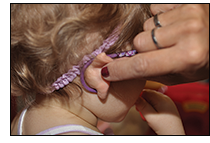
When adjusting the temples for a skull temple or a comfort cable, it is all about distributing the weight evenly over the entire length touching behind the ear. If a ridge is left anywhere behind the ear, it is too tight and should be re-adjusted. Comfort cables fit well here. They can be warmed up and molded to shape the back of the ear and hug along the side of the head. Once this adjustment is done, there are generally no marks left behind the ear at all.
See Plus »
|
|


|
BEVEL PLACEMENT, 1 OR 2
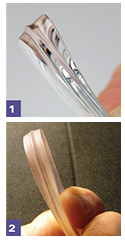
You take all of the right precautions, you order that -6.00 sph, OU Rx in a high-index product with anti-reflective coating, and you choose a zyl frame that fits the patient perfectly and that is thick enough to help camouflage the edge thickness. And what comes back from the lab looks a bit like this.
The excess thickness is the culprit here. When you mount the lenses, the temples of the frame now are much wider than they were prior to mounting the lenses. A bevel placed too near the front of the lens will cause too much excess behind the bevel, interfering with the back of the eyewire, which will cause the temples to flare out and ultimately leads to a patient who returns to your office again and again to have their glasses tightened up.
See Plus »
|
NURSING HOMES, METAL FRAMES AND FITTING TEMPLES
It is common knowledge that the frames covered by most government plans are very inexpensive and as a result, the plating wears off quickly, exposing the base metal. The exposed base metal soon oxidizes when it comes in contact with skin oils, and if the temple fit is too tight, it turns both the eyeglass temple and the wearer’s temple a lovely shade of green. This is not only unsightly and uncomfortable for the wearer; it is also unhealthy for the skin. Once the thin, mature skin is in contact with the green temple, it can soon develop an open sore, which exposes the patient to the risk of infection. Obviously, it is best to avoid these circumstances altogether. Nursing home residents have enough other health issues to contend with, so the best remedy in this regard is prevention.
When fitting the temples, be certain that there is enough clearance between the eyeglass temple and the wearer’s head to allow a piece of paper to slide in, unrestricted. When fitting temples, be certain that there is a gap of approximately 2 to 3 mm between the eyeglass temple and the wearer’s head. The only part of a metal temple that should touch the skin is the plastic temple tip. This will be more comfortable for the wearer and slow down the corrosion process.
See Plus »
|
ADJUSTING TITANIUM FRAMES
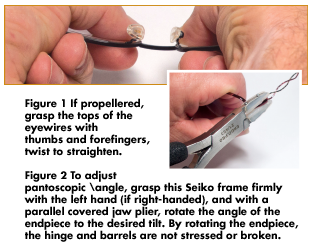
It happens but infrequently. That’s because they typically require less adjustment because of their tensile strength. When needed, follow the same steps as other metals.
Start with checking whether the front is propellered. In flat sheet-like titanium fronts (Fig. 1), it would take extreme force to get them propellered. As a result, propellering is rare. If it does happen, it’s a result of a narrow or thin bridge. Grasp both eyewires as shown in Fig. 1 with small twists, straighten the front and remove the propeller.
Changing pantoscopic angle requires the right pliers. Use pliers with metal jaws that are nylon covered. That ensures that the plier jaw will not mar the frame’s surface or finish.
Titanium frames with a thinner attachment point for the endpiece can be adjusted using a parallel jaw double-covered plier (Fig. 2) while bracing the front.
See Plus »
|
IT’S ALL ABOUT THE FRAME
If a kid’s frame is uncomfortable, kids won’t wear them. Therefore, consider that every frame is supplied with spring hinges for easier fitting, and they’ll take a kid’s everyday bumps, yet return to the right fitting position. For metal frames, adjustable nosepads ensure that the pads can match the shape of a developing nose. Each pad arm should be easily adjusted for position but a slightly stiffer pad arm retains its position longer. Soft silicone pads ensure that the frame sits firmly on the nose. All pads are attached with screws. That means that pads are more difficult to lose or remove; that makes them less edible for the smaller kids.
See Plus »
|
7-BARREL HINGES
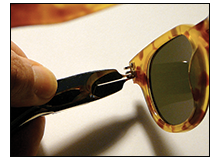
Adjusting for pantoscopic tilt gets more difficult as the number of barrels increases. Three-barrel hinges allow significant adjusting, seven-barrel hinges very little. To add tilt to a seven-barrel hinge, an old plier called a duckbill is helpful to angle the barrels individually, and a zyl or metal file is needed to change the angle of the butt end of the temple. Note however, in the photo that this frame has a set of front barrels on the frame front that are different lengths, longer on top, shorter on bottom to allow the correct pantoscopic angle. (Frame: Bentley from Victory Optical Collection)
See Plus »
|
FITTING PATIENTS, FORMING RELATIONSHIPS
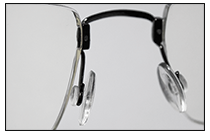
If the patient desires a larger bold plastic frame and has a small bridge, the optician can explain the benefits of plastic frames with nosepads.
If the patient has a very small distance between the eyes and ears, the optician may advise to select a frame with a metal temple that can be custom fit in length to avoid long, unsightly and uncomfortable temple ends behind the ears.
It is critical for the optician to imagine the final product. What are the glasses going to look like when they are finished? Will they be comfortable? How are they going to hold up? Will the final product match the patient’s expectation?
See Plus »
|
|